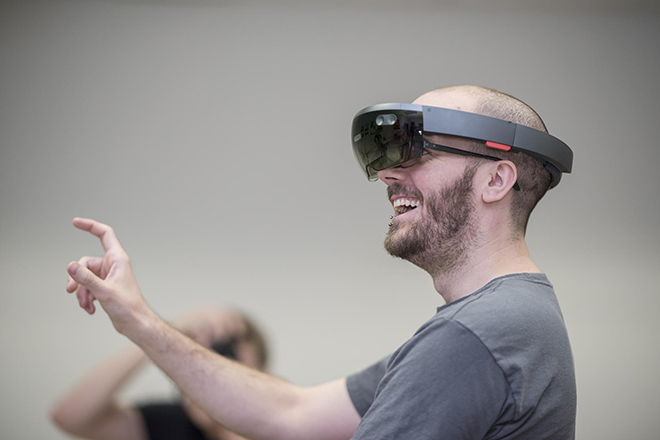CAGD / JOUR / MADT:
Learning to work together

Posted on December 1, 2017 at 12:00 PM
For the first time – perhaps in Chico State history – three departments, across two colleges are launching what they hope will be a long-term collaboration with great benefits to students from all three programs.
J&PR currently is collaborating with Media Arts, Design & Technology, its sister program in the College of Communication and Education, and Computer Animation & Game Development, which is housed in the College of Engineering, Computer Science and Construction Management at Chico State.
While working across three programs and two colleges presents a few challenges, the programs share a professional skills focus and dedication to technological engagement and experimentation.
All three programs have endorsed efforts to encourage students from their majors to learn and work together.
This mirrors both industry trends and the team structure employed by most media industry jobs.
First efforts at working together have included co-teaching a project-based class for fall 2017, CAGD/JOUR/MADT 398, “Virtual & Augmented Reality for Media & Gaming.”
This class put 10 students from each program into collaborative teams to develop a student-centered virtual Chico State campus tour for smartphones.
Special topics courses are one-time offerings that allow programs to try out new ideas and technologies and assess student interest before adding something to the permanent curriculum.
J&PR Department Chair Susan Wiesinger co-taught the course alongside Jennifer Meadows (MADT) and Jeff Underwood (CAGD), with 10 students from each program enrolled and working in multidisciplinary teams throughout the semester.
Students got the opportunity to work with virtual and augmented reality, earning them hands-on experience with state-of-the-industry technology for all three professionally focused programs.
J&PR used alumni donations to purchase a Microsoft HoloLens mixed-reality headset, as well as two Vuze 3D 360-degree cameras. All three programs additionally used student course fees and alumni donations to purchase a Google Cardboard-compatible, smartphone-based headsets for each student to use and keep.
Other immersive technology used during the semester included Oculus Rift, HTC Vive and Google Daydream headsets.
“The headsets are super immersive, you can’t see anything around you—not even your feet. You’re basically in another world.”
The main project students worked on during the semester was a virtual reality tour of the Chico State campus, focusing on the spaces that aren’t generally included on campus tours but are part of what the students love about Chico State.
The students, working in teams that included at least one student from each program, shot 360-degree video at assigned spaces using the Vuze cameras, then imported them into Unity, a game development platform.
Each student was able to share strengths and skills learned through their own program.
“I’ve really enjoyed interacting with journalism people and CAGD people,” said senior MADT major Vincent Urbino. “To step outside of your major is really cool.”
The class also often featured guest speakers from each area of focus. Debra Johnson, J&PR faculty, guest lectured about entrepreneurship and contrasting methods to fund digital media startups.
Later in the semester Michael Beadle, senior manager of public relations at Ubisoft and J&PR alumni, spoke to the class about Ubisoft’s engagement with AR and VR, and offered firsthand insight on job prospects in the gaming industry.
The virtual campus tour will eventually be available for public use on a smartphone app produced at the end of the semester.
A follow-up special topics course on applied VR/AR, also co-taught by faculty from the three programs, will be offered in spring 2018.
That class will focus on immersive storytelling during a semester-long collaboration with Sierra Nevada Brewery.
Future plans for the three-program collaboration include a cross-listed, introductory digital photography and evaluation of other courses with potential for shared content.
The hope is that sharing resources will increase technological engagement and instructional efficiency for all three programs and move students toward timely graduation – and fantastic careers.
Photos courtesy of Chico State photographer Jason Halley
_____
By Cassie Porter